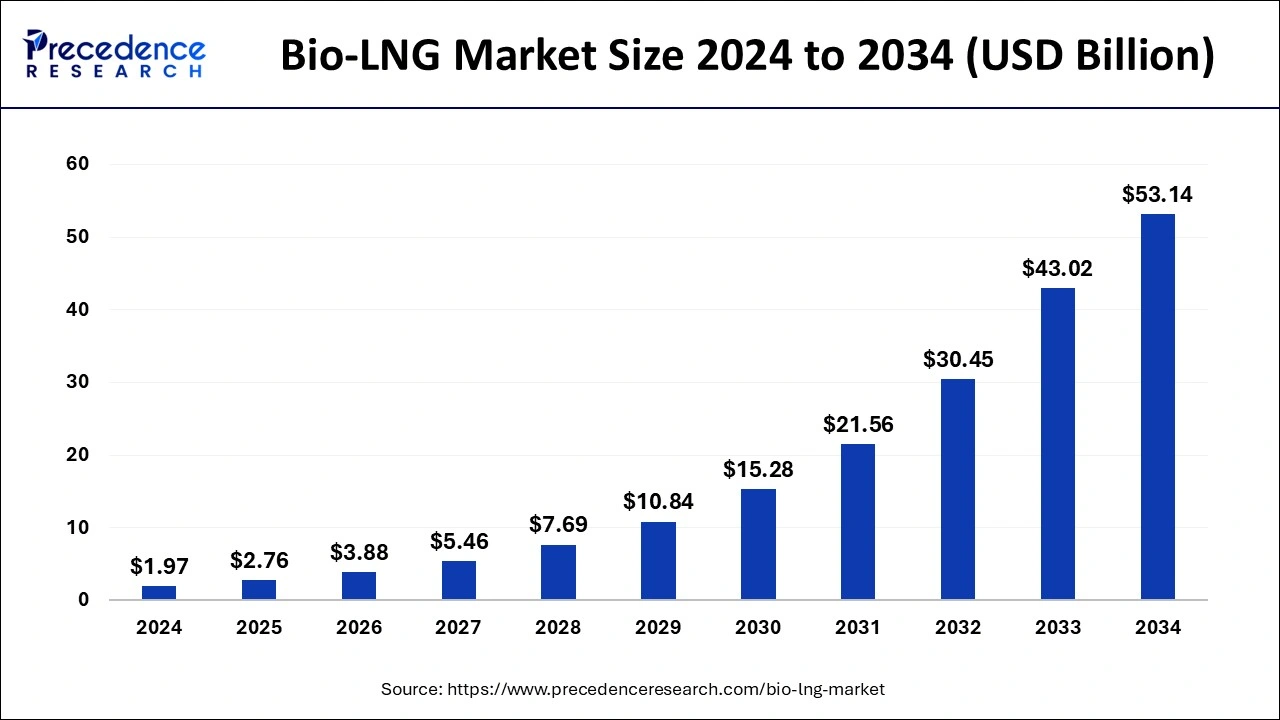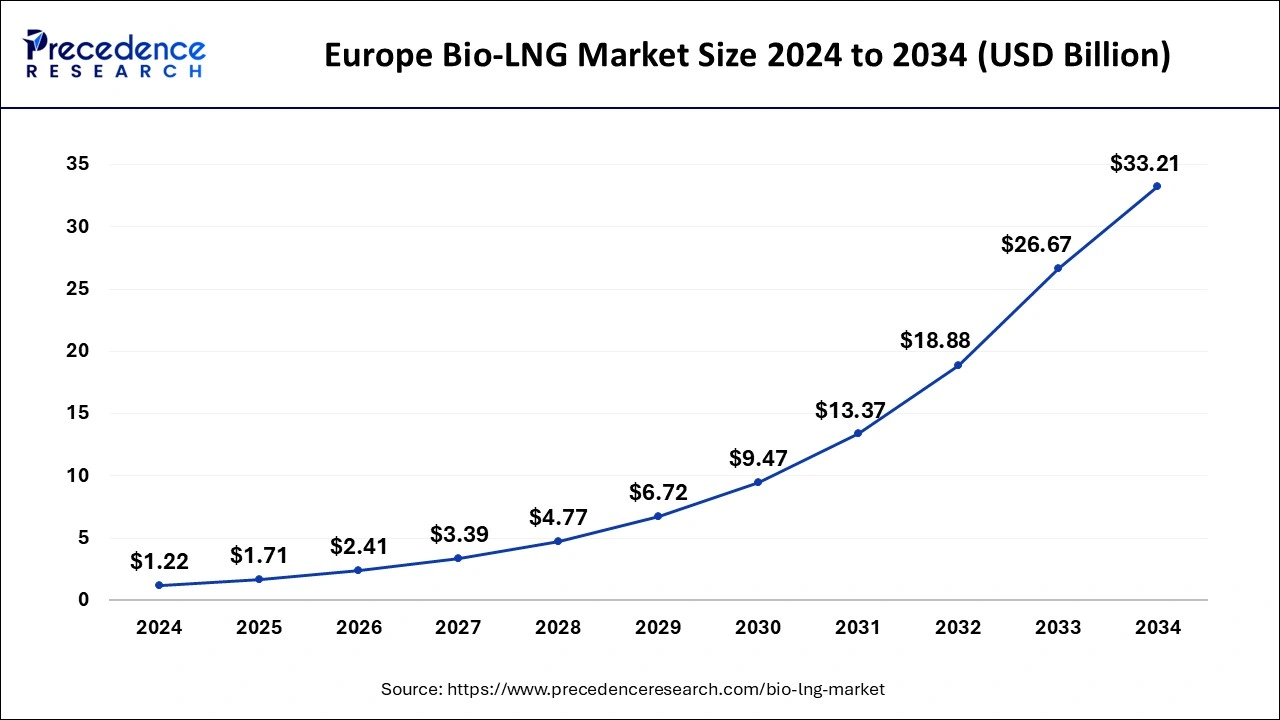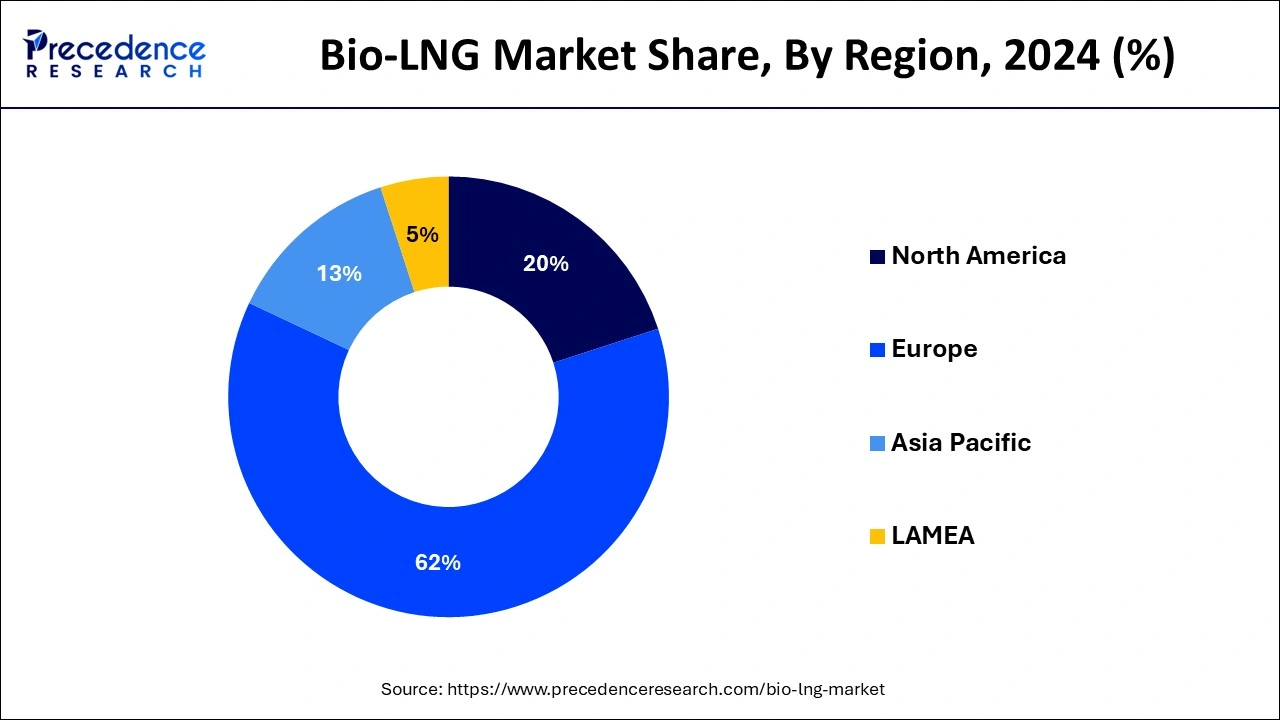The global bio-LNG market size is calculated at USD 2.76 billion in 2025 and is forecasted to reach around USD 53.14 billion by 2034, accelerating at a CAGR of 39.03% from 2025 to 2034. The Europe market size surpassed USD 1.22 billion in 2024 and is expanding at a CAGR of 39.15% during the forecast period. The market sizing and forecasts are revenue-based (USD Million/Billion), with 2024 as the base year.
The global bio-LNG market size was estimated at USD 1.97 billion in 2024 and is predicted to increase from USD 2.76 billion in 2025 to approximately USD 53.14 billion by 2034, expanding at a CAGR of 39.03% from 2025 to 2034. The bio-LNG market is driven by a growing concern about how traditional fossil fuels affect the environment.

The Europe bio-LNG market size was exhibited at USD 1.22 billion in 2024 and is projected to be worth around USD 33.21 billion by 2034, growing at a CAGR of 39.15% from 2025 to 2034.

Europe has its largest market share of 62% in 2024. European nations have led the way by enacting laws and policies that support renewable energy sources and lower greenhouse gas emissions. A supportive legislative and regulatory environment can propel the bio-LNG industry's expansion. Its goals for cutting carbon emissions and raising the proportion of renewable energy in its energy mix are high. Because of this dedication to sustainability, bio-LNG, a cleaner substitute for conventional LNG, may become more widely used. It frequently devotes a lot of funds to research and development in renewable energy. The competitiveness and appeal of bio-LNG technologies can be increased with ongoing investment in their development and improvement.

North America shows a significant growth in the bio-LNG market during the forecast period. Growing emphasis on cutting carbon emissions and achieving renewable energy goals may spur the use of bio-LNG, a greener fuel than conventional LNG. Technological developments in the bio-LNG production sector, such as enhanced feedstock conversion procedures and more productive production techniques, can raise bio-LNG's cost-competitiveness and investor interest. Energy sources with smaller carbon footprints are in greater demand as environmental sustainability and climate change become more widely recognized. Bio-LNG meets this need since it is made from renewable resources or organic waste.
The purchasing and selling of liquefied biomethane (LBM), referred to as bio-LNG, is called the bio-LNG market. The growing need for clean, sustainable energy sources drives this relatively new and quickly expanding business. Buses, heavy-duty trucks, and other vehicles can run on bio-LNG fuel. In comparison with traditional diesel, it provides a cleaner and lower-emission option. It can be used as a marine fuel, lessening the effect of shipping on the environment and assisting the maritime sector in adhering to tighter emission standards.
In industrial activities like manufacturing, food processing, and chemical manufacture that need high-temperature heat, it can replace conventional natural gas. Compared to traditional energy sources, bio-LNG is a dependable and greener energy source that may be used in power plants to create electricity.
| Report Coverage | Details |
| Growth Rate from 2025 to 2034 | CAGR of 39.03% |
| Market Size in 2025 | USD 2.76 Billion |
| Market Size by 2034 | USD 53.14 Billion |
| Base Year | 2024 |
| Forecast Period | 2025 to 2034 |
| Segments Covered | Source and Application |
| Regions Covered | North America, Europe, Asia-Pacific, Latin America, and Middle East & Africa |
Drivers
Growing demand for clean energy
Sustainable and ecologically friendly energy sources are becoming increasingly important as the world turns its attention to cutting greenhouse gas emissions and combating climate change. Bio-LNG is a feasible substitute for conventional fossil fuels since it is made from organic materials like organic waste, leftovers from agriculture, and other biomass sources.
By leveraging organic waste streams, bio-LNG contributes to the circular economy and has several advantages over conventional LNG. Often, organic materials are converted into biogas throughout its production process, which is then cleaned and liquefied to create bio-LNG. Developing a more sustainable energy environment and lowering dependency on fossil fuels align with this low-carbon, renewable fuel.
Increasing awareness of the environmental benefits of bio-LNG
Growing awareness has led to a greater emphasis on the environmental advantages of bio-LNG, which has helped to fuel its ascent in popularity as a substitute fuel. This tendency is consistent with a more significant worldwide movement toward ecologically friendly and sustainable energy sources.
Restraints
Lack of infrastructure and standardization
The need for more essential infrastructure, including distribution networks, storage facilities, and production units, hampers bio-LNG's widespread use. Furthermore, the business is unpredictable due to the need for established procedures and regulations, making it difficult for stakeholders to invest confidently in bio-LNG projects. The market for bio-LNG is growing slowly due to a need for more infrastructure and standards, which limits its potential to become a widely recognized and mainstream alternative in the energy industry.
Uncertain feedstock availability
Seasonality is a feature of several feedstocks utilized in manufacturing bio-LNG, including energy crops and agricultural leftovers. The availability of these resources is influenced by weather patterns and farming cycles, which causes variations in the feedstock supply all year. There may be competing uses for the same organic waste materials utilized in manufacturing bio-LNG, including composting, animal feed, or other agricultural uses. This resource rivalry may affect the steady supply of feedstocks needed to produce bio-LNG. The availability of waste streams is necessary for bio-LNG production, and modifications to waste management policies or procedures may impact the amount and caliber of feedstocks. Unclear waste management policies might impact the stability of the feedstock supply.
Opportunities
Growing demand for sustainable fuels
Growing public awareness of environmental degradation and climate change has increased demand for energy sources that lower greenhouse gas emissions. Conventional LNG derived from fossil fuels is less sustainable than bio-LNG derived from organic sources. Many companies are resolving to lessen their carbon impact and embracing sustainability objectives. Corporate sustainability initiatives might include bio-LNG as an alternative fuel that can help meet emission reduction goals. Various feedstocks, such as organic waste, agricultural residues, and specialty energy crops, can manufacture bio-LNG. This flexibility in raw materials lessens reliance on feedstocks by ensuring a steady and varied supply chain.
Government subsidies and incentives
In pursuing cleaner energy sources and reduced greenhouse gas emissions, many countries have set ambitious targets for renewable energy. Bio-LNG, as a renewable fuel, aligns perfectly with these objectives. As critical decision-makers, government officials have the power to shape more extensive clean energy plans, including promoting and expanding the bio-LNG sector. Governments can reward bio-LNG producers for reducing greenhouse gas emissions by implementing carbon credit systems or offset programs. The opportunity to trade these credits on carbon markets introduces an additional revenue stream, enhancing the financial attractiveness of bio-LNG plants.
Governments can stimulate the bio-LNG market by offering incentives for the construction of vital infrastructure, such as production facilities, storage facilities, and distribution networks. This support paves the way for a robust bio-LNG supply chain, promising a future where clean energy is readily accessible for enterprises and consumers.
The organic household waste segment dominated the market in 2024 with a 41% market share. Much of the world's municipal solid trash comprises organic home garbage, such as food scraps and yard debris. The conversion of the organic portion into renewable energy sources like bio-LNG is becoming increasingly important as governments and communities emphasize sustainable waste management methods.
Anaerobic digestion of biodegradable materials yields biogas in the organic waste-to-bio-LNG process. By liquefying this biogas, which is mostly made of methane, bio-LNG can be produced. Unlike conventional LNG from fossil fuels, this bio-LNG is an environmentally friendly and renewable substitute that reduces greenhouse gas emissions and reliance on non-renewable resources.
The municipal waste segment is expected to grow at the fastest CAGR during the forecast period of 2025-2034. For bio-LNG manufacture, municipal waste including organic and biodegradable materials, is a plentiful and easily accessible feedstock. Since this waste is often produced in cities, bio-LNG-producing facilities have a steady source. The idea of a circular economy, which recycles and repurposes resources, is gaining popularity worldwide. This architecture is particularly suited to generating bio-LNG from municipal trash, which turns waste materials into a lucrative energy source and encourages a more circular and sustainable approach to waste management. Technological developments in waste-to-energy and bio-LNG production have increased the economic viability and efficiency of turning municipal trash into bio-LNG. This area is attractive and scalable in part because of improved technologies.
The transportation fuel segment held the largest share of 56% in 2024. Reducing greenhouse gas emissions by switching to greener, more sustainable energy sources is becoming increasingly important worldwide. Because it is made from organic and renewable resources, bio-LNG is a better option for the transportation industry that wants to reduce its carbon footprint.
Bio-LNG can be used as a substitute for conventional fossil fuels, especially in heavy-duty vehicles like buses, trucks, and ships. It can be blended with or used instead of traditional LNG without requiring significant changes to the engines and infrastructure already in place. This is known as "drop-in" fuel. Because of its simplicity of integration, fleet operators looking for better energy options without major overhauls find bio-LNG a compelling alternative.
By Source
By Application
By Geography
For inquiries regarding discounts, bulk purchases, or customization requests, please contact us at sales@precedenceresearch.com
No cookie-cutter, only authentic analysis – take the 1st step to become a Precedence Research client